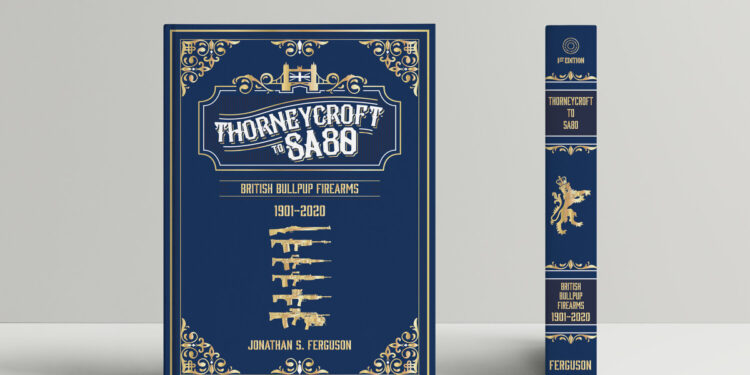Reviewed by Dean Roxby
Author Jonathan Ferguson has what may be the best job title ever. He is the Keeper of Firearms & Artillery at the Royal Armouries Museum in the United Kingdom. He is responsible for a collection which spans the full history of guns, from medieval times to the latest, most modern designs. He is also a Technical Specialist with Armament Research Services (ARES), a specialist technical intelligence consulting group. So yeah, he knows his stuff.
This book by Ferguson is the second title from Headstamp Publishing, a new publishing firm that seeks to become known for releasing “best-in-class” firearms books. Started by N.R. (Nic) Jenzen-Jones (Director of Armament Research Services), Ian McCollum (of Forgotten Weapons fame), and James Rupley (Photographer and Creative Director of the popular Vickers Guide book series). Their first release, From Chassepot to FAMAS, by Ian McCollum was reviewed in the May 2021 (V25N5) issue of SAR.
Arranged in chronological order, this new book examines the century long route from the earliest bolt-action bullpup prototypes from Thorneycroft and Godsal, to the current issue L85A3 service rifle. While neither the Thorneycroft nor Godsal were adopted, they did earn their spot in history as the first bullpups tested by the British Army. It covers the subject from both a technical aspect, as well as a political approach. Generally, a full chapter is given to each rifle. The SA80 has three chapters, as it has separate chapters for the A2 and A3 upgrades.
Shortly after the end of WWII, Britain again explored the bullpup concept. The relatively well known E.M. 2 (Janson’s Automatic Rifle, .280 inch), as well as lesser-known types such as the Korsak Light Automatic Gun, 7.92 mm, (E.M. 1), and Thorpe’s Automatic Rifle, .280 inch, (E.M. 1 aka ‘Cobra’) are covered in detail. The E.M. 2 and its 280 British (7x43mm) cartridge were actually adopted for British Army service on April 25, 1951. The rifle was given the designation Rifle, 7 mm, No. 9 Mk. I. Exactly six months later, on Oct 25, this decision was put on hold. This was mainly due to the U.S. Army refusing to accept the 7x43mm as a common cartridge, considering it to be underpowered.
Not too many years after firmly stating that the U.S. Army would not accept any round less than .30 caliber (7.62mm), the U.S. military adopted the 5.56mm round.
The SCHV (Small-caliber, high-velocity) concept interested the British as well, so they began to test different designs, finally settling on a 4.85x49mm round. Along with the new cartridge came a new bullpup rifle, the 4.85mm Enfield Weapon System (individual weapon and machine gun). In the end, the 4.85 EWS was not adopted, either. However, it did set the stage for the Small Arms of the 80’s program. (SA80 was the name of the overall program, while the British Army designation was L85A1 for the individual weapon, and L86A1 for the light support weapon.)
The SA80 coverage makes up a little under half of the book. This makes sense as the SA80 family actually saw combat in British service, unlike the previous types. As well, it has been in service since 1985, or 36 years. There is a chapter covering the path leading to the first A1 version, another chapter covering the A2 major upgrade done by HK, and the final chapter that details the current A3 version.
Ferguson mentions the book The Last Enfield: SA80 – the Reluctant Rifle by Steve Raw (Collector Grade Publications) several times throughout the SA80/L85 portion. I have not read the earlier “Reluctant Rifle” book myself (It is long out of print, and now quite expensive), but the quoted passages indicate that Raw doesn’t think too highly of the SA80 system at all. (To be fair, Raw’s book was released in 2003. The SA80/L85 has been upgraded twice since then.) Ferguson, on the other hand, freely acknowledges that the SA80 had a terrible few years but believes it has now matured into a solid rifle. However, it has been a costly journey. Ferguson factors in the original cost of the A1 and accessories, plus the A2 and A3 upgrades, the unit cost is around US$5200, compared to roughly US$700 for an M4 carbine. This huge cost is especially aggravating considering that a good deal of the issues resulted from bean-counters getting involved in the design process. The quote “engineering by accountants” was mentioned.
As noted above, Headstamp intends to be a premium quality publisher. They use premium quality paper stock that makes the photographs show beautifully. To quote their website, they use “commercial quality, section sewn style binding which allows the book to lay flat.” Three buying options are offered, a Standard edition for $98, a Signature edition for $128, and $250 for the Collector’s Limited Edition (500 numbered and signed). All three options include a faux leather hard cover binding with gold foil embossing, a sewn-in red ribbon marker, and gilded page edges, making this a fine quality book. Also available for purchase is a reproduction of an original E.M. 2 manual. My only minor complaint is that the size of type is quite small, so difficult to read.
This is a wonderful book, a fine addition to your library. Recommended.
| Title: | Thorneycroft to SA80: British Bullpup Firearms, 1901-2020 |
| Author: | Jonathon S. Ferguson |
| ISBN: | 978-1-7334246-2-2 |
| Copyright: | 2020 |
| Binding: | Hard cover, faux leather with gold foil embossing |
| Dimensions: | 7.5 x 10in |
| Pages: | 532 |
| Publisher | Headstamp Publishing LLC |
| Website: | headstamppublishing.com |
| MRSP: | $98-$250 |












